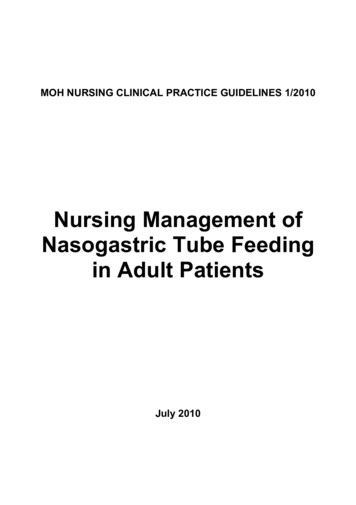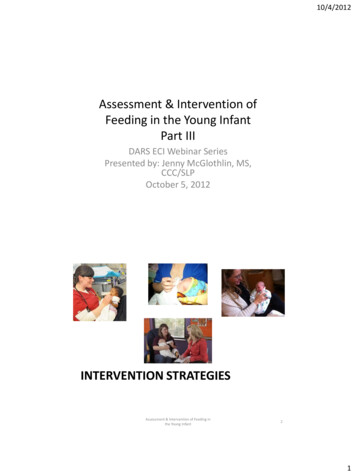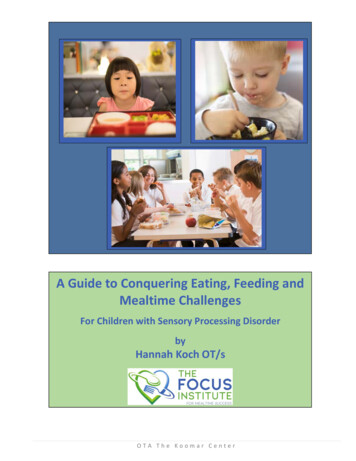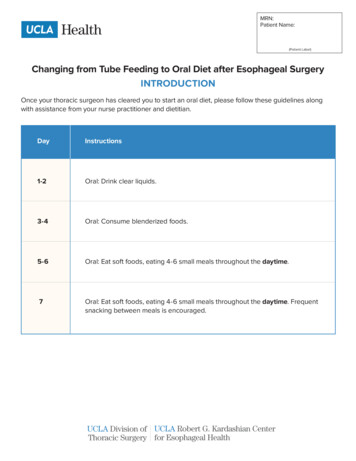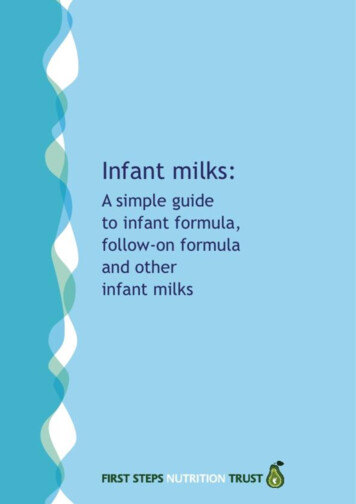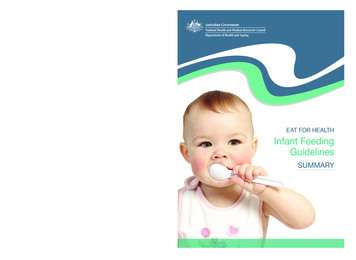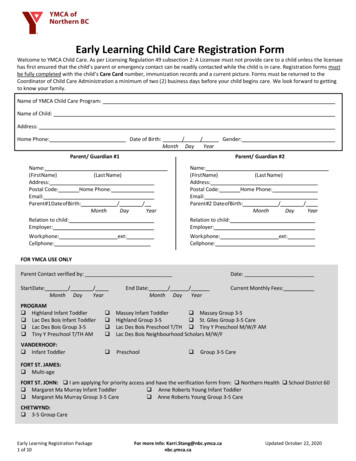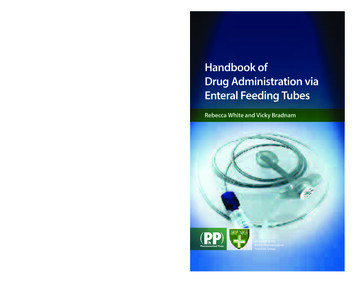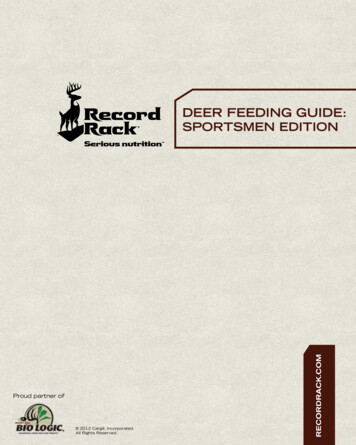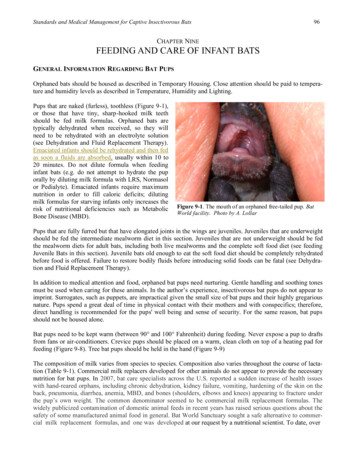
Transcription
Standards and Medical Management for Captive Insectivorous Bats96CHAPTER NINEFEEDING AND CARE OF INFANT BATSGENERAL INFORMATION REGARDING BAT PUPSOrphaned bats should be housed as described in Temporary Housing. Close attention should be paid to temperature and humidity levels as described in Temperature, Humidity and Lighting.Pups that are naked (furless), toothless (Figure 9-1),or those that have tiny, sharp-hooked milk teethshould be fed milk formulas. Orphaned bats aretypically dehydrated when received, so they willneed to be rehydrated with an electrolyte solution(see Dehydration and Fluid Replacement Therapy).Emaciated infants should be rehydrated and then fedas soon a fluids are absorbed, usually within 10 to20 minutes. Do not dilute formula when feedinginfant bats (e.g. do not attempt to hydrate the puporally by diluting milk formula with LRS, Normasolor Pedialyte). Emaciated infants require maximumnutrition in order to fill caloric deficits; dilutingmilk formulas for starving infants only increases therisk of nutritional deficiencies such as MetabolicBone Disease (MBD).Figure 9-1. The mouth of an orphaned free-tailed pup. BatWorld facility. Photo by A. LollarPups that are fully furred but that have elongated joints in the wings are juveniles. Juveniles that are underweightshould be fed the intermediate mealworm diet in this section. Juveniles that are not underweight should be fedthe mealworm diets for adult bats, including both live mealworms and the complete soft food diet (see feedingJuvenile Bats in this section). Juvenile bats old enough to eat the soft food diet should be completely rehydratedbefore food is offered. Failure to restore bodily fluids before introducing solid foods can be fatal (see Dehydration and Fluid Replacement Therapy).In addition to medical attention and food, orphaned bat pups need nurturing. Gentle handling and soothing tonesmust be used when caring for these animals. In the author’s experience, insectivorous bat pups do not appear toimprint. Surrogates, such as puppets, are impractical given the small size of bat pups and their highly gregariousnature. Pups spend a great deal of time in physical contact with their mothers and with conspecifics; therefore,direct handling is recommended for the pups' well being and sense of security. For the same reason, bat pupsshould not be housed alone.Bat pups need to be kept warm (between 90 and 100 Fahrenheit) during feeding. Never expose a pup to draftsfrom fans or air-conditioners. Crevice pups should be placed on a warm, clean cloth on top of a heating pad forfeeding (Figure 9-8). Tree bat pups should be held in the hand (Figure 9-9)The composition of milk varies from species to species. Composition also varies throughout the course of lactation (Table 9-1). Commercial milk replacers developed for other animals do not appear to provide the necessarynutrition for bat pups. In 2007, bat care specialists across the U.S. reported a sudden increase of health issueswith hand-reared orphans, including chronic dehydration, kidney failure, vomiting, hardening of the skin on theback, pneumonia, diarrhea, anemia, MBD, and bones (shoulders, elbows and knees) appearing to fracture underthe pup’s own weight. The common denominator seemed to be commercial milk replacement formulas. Thewidely publicized contamination of domestic animal feeds in recent years has raised serious questions about thesafety of some manufactured animal food in general. Bat World Sanctuary sought a safe alternative to commercial milk replacement formulas, and one was developed at our request by a nutritional scientist. To date, over
Standards and Medical Management for Captive Insectivorous Bats97300 insectivorous bat pups of various species have been raised successfully to adulthood using the Bat World Sanctuary Milk Replacement Recipe (Table 9-2).Once a milk formula has been prepared, an electric coffee cup or candlewarmer can be used to keep it warm during feeding sessions, althoughformula will scald if the container is placed directly on the warmer. Instead, place the container of formula in a shallow bowl of warm water andplace the bowl of water on the coffee cup warmer (Figure 9-2).Constantly monitor the temperature. Bat pups typically prefer milk formula at a temperature that feels somewhat warmer (115 to 120 Fahrenheit) on the wrist than that considered appropriate for human infants. Ifthe formula becomes too hot, remove it from the heated water for a fewmoments until it cools sufficiently. Feeding tools that become cloggedwith thickened formula during feeding can be rinsed clean in the warmedwater.Figure 9-2. A coffee warmer workswell to warm milk . Photo by A. LollarFEEDING SCHEDULEIt takes only a small amount ofmilk formula to fill the stomachsof most pups. Because some infants are naked or sparsely furredfor the first few weeks of life,milk formula can clearly be seenthrough the skin of the abdomen.Depending on the size, age, andcondition of an infant, it willtake anywhere from a few dropsto 1.0ml of milk formula perfeeding. Pups of most speciesshould not be allowed to drinkmore than 1.0ml per feeding;serious gastric disturbance canresult from overfeeding. Pupstaking 1.0ml of formula per feeding should not be fed more thanfour times per day (once everysix hours). Because foam feedingtips (see page 97-98) precludeexact measurement of formulaconsumed, visual or tactile examination should be used to determine when a pup is full. Thestomach should be moderatelyrounded, but not bulging withmilk (Figure 9-3). A distendedabdomen indicates the pup hasbeen allowed to drink too much,a condition that can be fatal (seeOverfeeding in this section).Figure 9-3. A male red bat orphan after being fed the proper amount of milk formula, which resulted in the abdomen being moderately rounded without beingdistended. L. borealis. Bat World facility. Photo by A. Lollar
Standards and Medical Management for Captive Insectivorous Bats98Regardless of the species or the age of an infant, feeding schedules should be determined by the amount of timeit takes for an individual pup’s stomach to empty. To determine an infant’s feeding schedule, first become familiar with the look and the feel of the pup’s abdomen both before and after its first feeding. Take note of the visualappearance and how the abdomen feels when gently palpated with the fingertips. Note the time and check thepup each hour thereafter. Do not let the stomach empty completely and appear concave. Keep enough formula inthe pup at all times to keep the abdomen flat to moderately rounded (Figure 9-2). Feed the pup again when themilk formula is nearly gone (i.e., when the stomach is almost flat, or only a small amount of milk formula isvisible in the stomach). If the pup is already furred, milk will not be visible through the abdomen and the handlerwill need to rely solely on tactile examination. Note the time it took for the stomach to empty in order to estimate when the next feeding will be due. Feeding infants too often can result in bloat, i.e., distention of the stomach and severe abdominal distress, which can lead to death (see Complications in this section). Most pups willinitially require feedings every four to six hours (four to six times a day) depending on their condition, althoughsome pups’ stomachs may empty in as little as two hours. Younger pups and pups that are emaciated will need tobe fed more often than older pups that are healthy. In other words, as pups grow older and become healthier, thenumber of feedings per day will decrease.Important NotesPups can aspirate fluids or choke on food while being hand-fed. A bat may be choking if it suddenly coughs,gags and/or appears to gasp for breath during feeding. If aspiration is suspected, keep the bat’s head down withthe abdomen against the palm of the hand. Gently but firmly tap the bat’s back with your index finger, just below the shoulder blades to force the substance from the airway. Force of tapping should be no more than that thatof fingertips lightly drumming a tabletop. Fluid in the nasal passages should be cleared by applying gentle pressure with a cotton swab on the nasal passages just below the eye and down the bridge of the noise. Wipe awayany fluid that is expelled from the nose, and repeat the process until the nose is clear. Normal respiration willsometimes be restored immediately. However, if liquids or food enters the lungs, the bat is likely to develop aspiration pneumonia. Signs of respiratory distress include soft squeaky, wheezy, or rattling sounds with eachbreath, often audible even without a stethoscope. Treat as described in Respiratory Disorders.After feeding, the face and body should be gently wipedclean. Use soft make-up sponges or gauze pads dampenedwith warm water for this purpose. Be extremely gentle whenwiping the faces of pups. Avoid using so much pressure thatthe pup’s head moves with the gauze or sponge. In otherwords, the pup’s head should remain stationary as its face isbeing wiped cleaned. In addition to causing discomfort to thepup, too-aggressive cleaning may damage tissue or force foodparticles into the pelage, resulting in skin infection or lesions.Never put a pup away with milk on its face or body. Doingso will result in eye infections and/or skin infections that mayresult in death.Tree bat pups will need to be stimulated to initiate urinationand defecation. Cotton swabs are too rough for this purpose.Instead, use a the corner of a gauze pad that has been dippedin warm water (Figure 9-4) to gently flick the pup’s anus andgenitals. Use only the corner to softly flick the area. Flickrepeatedly until the pup urinates or defecates. While newborntree bats require stimulation, most of the crevice species donot. (Also see Bathing and Grooming Tree Bat Pups in thissection).Figure 9-4. Use only the corner of a dampenedgauze pad to stimulate tree bat pups to urinate anddefecate. Cotton swabs are too rough for this purpose. Bat World facility. Photo by A. Lollar
Standards and Medical Management for Captive Insectivorous Bats99FEEDING CREVICE BAT PUPSVespertilionidaeBat pups in the family Vespertilionidae will typicallylap fluids and accept a drop-by-drop method of feeding. Begin by holding the pup upside down. This isextremely important because infants are likely to aspirate fluid into the lungs when learning to lap formula if the head is not kept lower than the rest of thebody. Placing a small amount of warm formula ontothe pup’s mouth typically induces a lapping response.Continue to dispense the formula drop-by-drop as thepup drinks (Figure 9-5). Vespertilionidae pups thatdo not readily lap milk should be allowed to nursefrom foam tips (Figure 9-6B) as described below.Figure 9-5. An orphaned big brown pup lapping milk formula from a cannula. E. fuscus. Photo by D. Wilkins.MolossidaeMolossidae species will not lap liquids. It is critical that milk beoffered to these pups through soft foam sponges. Natural or whitefoam eye-shadow applicator tips (Figure 9-6A) are used for thispurpose (Lollar, 1994). Remove the foam tip from the plasticwand by immersing the wand in hot water to loosen the foamfrom the plastic wand, then slide the foam tip off the wand.The foam tip has a seam that runs along the entire edge of the tip(Figure 9-3B1). While the tip is still wet, tear the tip in half alongthe seam to form two matching halves (Figure 9-6B2). Use smallscissors to cut the tip of the foam into a wedge shape (Figure 96B3). This size and shape is readily accepted by bat pups.When nursing from foam tips, pups should be placed abdomendown on a heated surface to keep them warm. Heating pads canbe utilized for this purpose. The medium setting appears to be themost comfortable for crevice pups. There should be two layers ofcloth between the pup and the heating pad to prevent thermalburn. Fold a clean, absorbent cloth on top of the pad to absorbexcess formula during each feeding. Allow the cloth to warm before placing the pup into the folds for feeding. Cover the pup’sbody with the cloth, leaving only the head exposed, as shown onthe following page. Use a clean, dry cloth for each feeding.Begin by positioning the forceps on the foam (Figure 9-6C) sothat the prongs are somewhat buried in the foam. This protectsthe pups mouth. Dip the foam tip into warmed formula. The tipshould remain in the formula for several seconds to absorb heat.Remove excess formula by dabbing the tip on a paper towel. Excess formula on foam tips can cause choking or be uncomfortableto the pup. Test the temperature of the tip against the inside of thewrist.Position the index finger on one side of the pup’s face, and thethumb on the opposite side. While gently immobilizing the pup’shead, use the other hand to dip the foam tip into the formula.AFigure 9-6. A: Foam eye shadow applicatorsavailable at cosmetic stores.123BFigure 9-6. B: A foam tip removed from thewand and slightly separated at the seam. 2: thefoam tip torn in half at the seam. 3: The tip hasbeen trimmed to resemble a wedge shape.CFigure 9-6. C: The prongs must be buried inthe foam to protect the pups mouth as the tip isintroduced. Photos by A. Lollar.
Standards and Medical Management for Captive Insectivorous BatsEncourage the pup to take the tip by gentlylifting the pup’s head, which usually causesthe pup to open its mouth. If the pup does notopen its mouth, use the foam tip to very gently push the lower jaw down while sliding thetip into the mouth. Making soft clickingsounds during this process. Soft clickingmimics the directive calls some mother batsand pups use to locate each other. Most pupswill either begin nursing, or at least swallowsome of the formula. (The tragus will moveup and down slightly each time the pup swallows.)When the pup begins to nurse, releasethe forceps from the sponge tip as the pupwill keep it clamped between its teeth(Figure 9-7A and B).As the pup continues to nurse, warm formulacan be added to the tip one drop at a time.Be careful to drop the formula onto the portion of the foam tip that is furthest from thepup’s face, so that any excess milk formuladrips away from the infant.AFigure 9-7. A: A new born free-tailed pup nursing from a foam tip.T. brasiliensis. Bat World facility. Photo by A. Lollar.Some pups are difficult to feed and will spitthe foam tip out of their mouth. Some willswallow a few drops of formula but will notbegin sucking. These pups will eventuallystart nursing once they overcome initial fearof the handler.Some pups will discard the foam tip as soonas they are full; others will hang onto the tipeven after they have stopped drinking milk(Figure 9-7C). Do not try to remove the tipfrom a pup’s mouth. Any remaining formulain the tip may be accidentally forced downthe pup’s throat, causing it to aspirate. Thesepups will eventually discard the tip after being returned to the incubator. Foam nursingtips should be disposed of after use and replaced with new ones for each feeding.It is important to note that when some pupsare first handled, they will immediately graspthe cloth or fabric that encloses them withtheir milk teeth, refusing to let go. Do notattempt to remove the pup’s teeth from thefabric. Instead, carefully dispense warmedformula onto the cloth just below the pup’smouth and allow the pup to suck the formulafrom the fabric.100BFigure 9-7. B: Big brown pups nursing from foam tips. E. fuscus.Bat World facility. Photo by A. Lollar.CFigure 9-7. C: An evening bat pup clutching a foam tip. N. humeralis. Bat World Lone Star facility. Photo by D. Hyatt.
Standards and Medical Management for Captive Insectivorous Bats101Caring for large numbers of orphaned pups requires some modifications in care procedures. Over the course ofseveral days, some pups can be conditioned to being fed in groups (Figure 9-8). Pups that lap formula can betaught to drink from shallow dishes. Hold a pup over a shallow dish of warmed formula while feeding it from acatheter or dropper. While the pup is lapping, move the catheter away and carefully lower the pup until it drinksfrom the shallow dish. Be careful not to immerse the bat’s nose in the formula. Once a group has been individually taught to lap formula from a shallow dish, they can be fed in groups on top of a heating pad.When feeding pups from foam tips, each pup should be nursing from its tip and covered before the next pup isplaced into position.Figure 9-8. A row of orphaned free-tailed pups nursing from foam tips. T. brasiliensis. Photo by R. Myers.HOUSING CREVICE BAT PUPSUnfurred infants require warm temperatures and high humidity, and should be housed in humidity chambers asdescribed in Temperature, Humidity and Lighting. Caging described for adult crevice bats in Temporary Housing is also appropriate for crevice bat pups. A heating pad should be attached to the top and sides of the cage foradditional warmth. Infant crevice bats should be placed in a pouch positioned close to a heat source. Be sure toleave at least two of the walls of the cage clear of the heating pad so that infants can move away from the heatsource if needed. A thermometer should be placed inside the cage and close to the heat source to monitor theinternal temperature at all times. Heating pads can be adjusted and added or removed according to the temperature reading inside. Appropriate temperatures for many species of bat pups are 90 to 100 Fahrenheit and appropriate humidity levels range from 70% to 90%. Infant crevice bat pups and tree bat pups can be housed togetherwhen conspecifics are not available. Hand-raised crevice pups should be moved into full-sized flight cages withpadded floors by six to eight weeks of age to ensure development of proper flight ability.
Standards and Medical Management for Captive Insectivorous Bats102FEEDING TREE BAT PUPSUnlike crevice pups, tree bat pups must be fed formula while being hand-held. The pup should be fed under aheat source, such as a lamp, for warmth. It is critical to keep these pups clean during the feeding process. Treebats are furred at a very young age. If formula drips into the fur and dries on the skin, it can result in serious skininfections that may lead to death. Additionally, matted and dirty fur can interfere with a bat’s ability to thermoregulate. A pup can die within just a few hours if it cannot thermoregulate. Pups that become soiled must bebathed and dried as described on the following page. As a general rule it takes about 30 seconds to feed a tree batpup when fed correctly; it takes about 30 minutes to clean the pup when fed incorrectly.Position the pup so it lies prone on the thumb, secured by the forefinger and middle finger resting on the pup’sshoulder blades. Using a glass medicine dropper, dispense formula drop by drop as the pup laps. Although sometree bat pups squirm when first being held in this position, most catch on quickly and sit quietly on the thumbthereafter to be fed. Some enthusiastic pups attempt to crawl forward, appearing intent on swallowing the entiredropper. These pups can be controlled with gentle pressure of the fingertips on the pup’s shoulder blades.Both the pup and the medicinedropper should be tilted in a“V” position, so that the pup’smouth and the dropper meet atthe bottom of the V (Figure 99). This position helps to keepair bubbles from forming inthe dropper and prevents soiling by allowing excess milk todrop away from the pup’s face.If the pup’s head does not extend past the end of yourthumb, milk will wick betweenthe thumb and the pup, andsaturate the fur on the chin,neck and chest. Therefore, it iscritical that the pup’s head extend past the thumb tip so thatmilk drops away from both thethumb and the pup.HOUSING TREE BAT PUPSFigure 9-9. An orphaned red bat drinking milk formula from a medicine dropper. L.borealis. Photo by L. Crittenden.Infants require warm temperatures and high humidity, and should be housed in humidity chambers as describedin Temperature, Humidity & Lighting. Caging described for adult tree bats in Temporary Housing is appropriatefor tree bat pups. A heating pad should be attached to the top and sides of the cage for additional warmth. Besure to leave at least two of the walls of the cage clear of the heating pad so that the infant can move away fromthe heat source if needed. A thermometer should be placed inside the cage and close to the heat source in orderto monitor the internal temperature at all times. Heating pads can be adjusted and added or removed according tothe temperature reading inside. Appropriate temperatures for bat pups of many species are 90 to 100 Fahrenheit with humidity levels of 70% to 90%.Infant tree bats should be positioned so they can hang by their feet from the ceiling of the cage, not the sides.Hanging from the ceiling allows pups to urinate and defecate without becoming soiled. Position the pups so thatseveral can hang together in a cluster. Infant crevice bat pups and tree bat pups can be housed together whenconspecifics are not available. Hand-raised tree bat pups should be moved into full-sized flight cages with padded floors by four to six weeks of age to ensure development of proper flight ability.
Standards and Medical Management for Captive Insectivorous Bats103As mentioned earlier, tree bat pups should be stimulated after each feeding with a soft make-up sponge to encourage urination/defecation. If not stimulated, pups tend to urinate and defecate on themselves, which, if notcleaned and dried immediately, is likely to cause hypothermia and death.Be careful not to contaminate the oral or nasal cavities with fecal material by touching the face with the samesponge used to stimulate urination and defecation. This can result in serious bacterial infection from Providenciarettgeri, resulting in a build-up of fluid in the thoracic cavity and subsequent death (D. Cottrell, DVM., pers.comm.). Also be sure to keep wing tips free of feces to prevent fungal infection. If wing tips become soiled, gently clean with warm water and dry with a soft cloth. (Fungal infections will cause wing tips to become discoloredand oily in appearance. This condition is very painful and should be treated with daily applications of Nolvasansuspension as described in Skin Conditions.)Bathing and Grooming Tree Bat PupsItems required for cleaning and grooming a bat include a heating pad, a bowl of warm water, a curve-tipped syringe, an interdental brush (a small tapered brush used for cleaning between human teeth), gauze pads, soft, absorbent cloths for drying, and a travel-size hair dryer (see Products). Pre-warm a few absorbent drying cloths byplacing them on a heating pad. Keep the heating pad on a medium setting. Water may need to be replaced periodically throughout the procedure as it cools or becomes soiled.Begin cleaning by holding the bat securely in the palm of the hand, keeping its head higher than the rest of thebody so that no water gets near the nose or mouth. If only a small section of the bat is soiled, dip a gauze padinto warm water, then saturate the soiled area on the bat and slide off any foreign particles. For bats that are extremely soiled with feces or other matter, use a curve-tipped syringe to saturate the soiled area. Do not squirtwater on or near the bat’s head. When thoroughly saturated, feces and other foreign particles will slide easilyfrom the fur as the area is gently wiped with a damp gauze pad. If the hair is not damp enough, it will be pulledout when attempting to remove feces from the fur. Also be sure to clean the wings of badly soiled bats. Hold thebat in a horizontal position, extend one wing, use the curve-tipped syringe to squirt water liberally over the surface, and again gently slide off any particles of food or feces that have adhered to the membrane. Use the sameprocedure for the other wing and the tail membrane.As soon as the fur is clean, quickly place the bat in a pre-warmed, absorbent drying cloth on top of the heatingpad. Wrap the cloth around the bat and gently dab the wet areas of its body with the cloth to absorb excess moisture. Replace the cloth with another warmed one when it becomes damp. After gently towel drying the fur, wrapthe pup inside another dry cloth and turn it upside down, keeping the head lower than the rest of the body, andcarefully wipe the mouth and face with a damp piece of gauze. Make sure the gauze is only slightly dampened sothat no excess water can be inhaled during cleaning.After gently rubbing the bat’s fur, and wing and tail membranes with a soft, dry cloth to absorb excess moisture,use a blow dryer to finish drying the fur. Pups can either be held in the palm of the hand while being dried, orplaced in a BatHut in front of the blow dryer. The dryer should be placed at least one foot from the bat. If a pupsquirms to get away while being held, the dryer is too close and the air stream is too forceful or too hot. Keep thedryer at an appropriate distance so that the bat remains passive, enjoying the warmth.Fluff the fur with the interdental brush while drying the pup. Brush the dense fur backwards to dry the fur closestto the body, then brush the fur forwards in the natural direction it lays, to dry the top of the fur. Only minimalpressure should be used when brushing a bat. (To fully realize the small amount of pressure needed, place thebristles on a sensitive area of your body, such as the inside of your wrist or elbow, and then brush in one direction.) Make certain the pup is completely dry—both the fur and wing membranes—before returning it to itscage. Tree bat pups will usually begin grooming their bodies vigorously once they have been bathed and dried.
Standards and Medical Management for Captive Insectivorous Bats104BAT WORLD SANCTUARY MILK REPLACEMENT RECIPEVespertilionidae 3.5 ounces (100ml) canned Meyenberg evaporated goats milk that has been reconstituted with filtered water1.5ml organic or unrefined corn oil0.5ml cold pressed flax oil1.5 scoops (12.9g) Similac Go & Grow, Soy-Based Powder2 level tsp (4.3g) dried egg white.Reduced oil formula for newborn to three weeks: Decrease oil by half if stools become loose.Tree bats four weeks and older: Mix milk with an equal amount of soft food.Use a small food storage container with a tight-fitting lid to mix and store. To the container add 3.5 ounces ofMeyenberg goats milk that has been reconstituted with an equal amount of filtered water. Add 1.5 scoops Similac Go & Grow Powder, 2 tsp dried egg white, 1.5ml corn oil and 0.5ml flax oil. Shake well to mix. (Makesabout 1/2 cup. Divide the above measurements by half if a smaller amount is needed.) Store in the refrigerator.Do not freeze. Discard after 24 hours or sooner if it begins to thicken or smell spoiled. Wash container thoroughly and rinse well before mixing new batches of formula. Store goats milk in the refrigerator and discard anyunused milk after five days or sooner if it begins to smell spoiled. Store Go & Grow Powder at room temperature and discard any unused powder after 30 days.Calculated Nutrient Values (As Is)Energy 1.42 kcal/ml; Moisture 73.5%; Protein 7.3%; Fat 8.2%; Carbohydrate 9.8%; Calcium 0.20%; Phosphorus 0.15%;Vitamin A 3,340 IU/kg; Vitamin D 430 IU/kg.Calculated Nutrient Values (Dry Wt)Energy 5.36 kcal/ml; Protein 27.4%; Fat 30.9%; Carbohydrate 36.8%; Calcium 0.75%; Phosphorus 0.58%; Vitamin A12,500 IU/kg; Vitamin D 1,650 IU/kg.Molossidae 3.5 ounces (100ml) canned Meyenberg evaporated goats milk that has been reconstituted with filtered water2 scoops (8.6g each) Similac Go & Grow, Soy-Based Powder2.0ml organic or unrefined corn oil1.0ml cold pressed flax oilUse a small food storage container with a tight-fitting lid to mix and store. To the container add 3.5 ounces ofMeyenberg goats milk that has been reconstituted with an equal amount of filtered water. Add 2 scoops Similac Go & Grow Powder, 3.0ml of corn oil and 1.0ml of flax oil. Shake well to mix. (Makes about 1/2 cup. Dividethe above measurements by half if a smaller amount is needed.) Store in the refrigerator. Do not freeze. Discardafter 24 hours or sooner if it begins to thicken or smell spoiled. Wash container thoroughly and rinse well beforemixing new batches of formula. Store goats milk in the refrigerator and discard any unused milk after five daysor sooner if it begins to smell spoiled. Store Go & Grow Powder at room temperature and discard any unusedpowder after 30 days.Calculated Nutrient Values (As Is)Energy 1.60 kcal/ml; Moisture 72.2%; Protein 4.7%; Fat 10.7%; Carbohydrate 11.2%; Calcium 0.22%; Phosphorus 0.16%;Vitamin A 3,830 IU/kg; Vitamin D 540 IU/kg.Calculated Nutrient Values (Dry Wt)Energy 5.76 kcal/ml; Protein 17.0%; Fat 38.5%; Carbohydrate 40.3%; Calcium 0.79%; Phosphorus 0.59%; Vitamin A13,700 IU/kg; Vitamin D 1,900 IU/kg.
Standards and Medical Management for Captive Insectivorous Bats105TABLE 9-1COMPARISON OF BAT MILK ily: VespertilionidaeEptesicus fuscusEarly lactation12.89.53.66.7Late lactation21.29.53.610.5Early lactation12.49.43.97.4Late lactation15.88.53.98.6Milk replacement recipe:Vespertilionidae8.27.39.85.6Early lactation17.38.33.69.0Peak lactation25.87.73.412.1Milk replacement recipe:Molossidae10.74.711.25.8Myotis lucifugusFamily: MolossidaeTadarida brasiliensisNote: The amino acid profile in the Molossidae milk replacement recipe is very good,thereby minimizing the need for excess protein.
Standards and Medical Management for Captive Insectivorous Bats106TABLE 9-2PUP SURVIVAL RATES FOR SELECT MILK REPLACEMENT FORMULAS Year# darycomplicationsDied fromsecondarycomplicationsDiedfrominjurySurvival Rate(Number and(Percentage)Formulaused199947T. brasiliensis2253440 (85.1%)MH*535E. fuscusL. borealis—2—7MBD (4)Bloat (2)—Bloat (3)———55 (100%)30 (85.7%)MH*355526228N. humeralisT. brasiliensisL. borealisT. brasiliensisL. borea
should be fed the intermediate mealworm diet in this section. Juveniles that are not underweight should be fed the mealworm diets for adult bats, including both live mealworms and the complete soft food diet (see feeding Juvenile Bats in this section). Juvenile bats old enough to eat the soft food diet should be completely rehydrated
